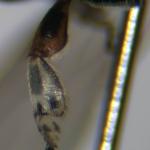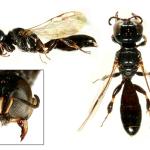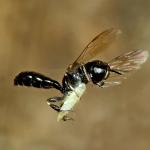Crabro nigritus (GIMMERTHAL,1836); Crabro ambiguous (DAHLBOM,1842); Crabro capito (DAHLBOM,1845); Blepharipus gonager (LEPELETIER & BRULLÉ,1835); Blepharipus parkeri (BANKS,1921); Crabro davidsoni (SANDHOUSE,1938)
Richards (1980) considered this species to be local but widespread throughout the British Isles northwards to Inverness, although much more common in the south. Currently available data suggests it is still generally spread across England, with no data for the rest of the British Isles. Lomholdt (1984) states that this is a wasp of only sporadic occurrence in Denmark and Fennoscandia, although widely spread across Europe, and with records from Kazakhstan, Mongolia, China and Japan. It is also found in north-eastern USA and adjacent parts of Canada.
This species is not considered to be under threat.
Found in a wide variety of habitats, where suitable nesting substrates occur.
Richards (1980) gives May to September, but the data set currently available indicates a bias towards the second half of this period, with only one record for May (27th, at Brandon in Norfolk).
Hemipteran bugs, generally from the family Typhlocybidae (Lomholdt 1984), although reference is also made to the taking of small Psyllid and Mirid bugs as well.
Nests are constructed in dead and occasionally rotting broadleaved or coniferous wood. Large nests may be provisioned with up to 500 bugs, spread throughout 20 cells (Lomholdt 1984).
No information is available.
No information is available.
2006








